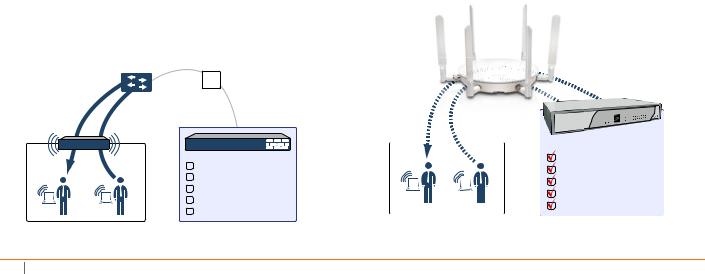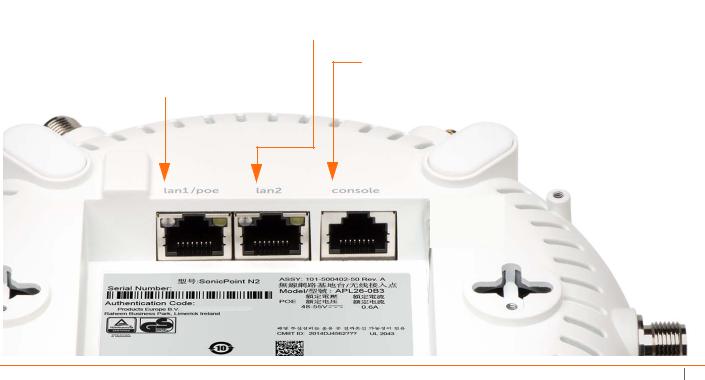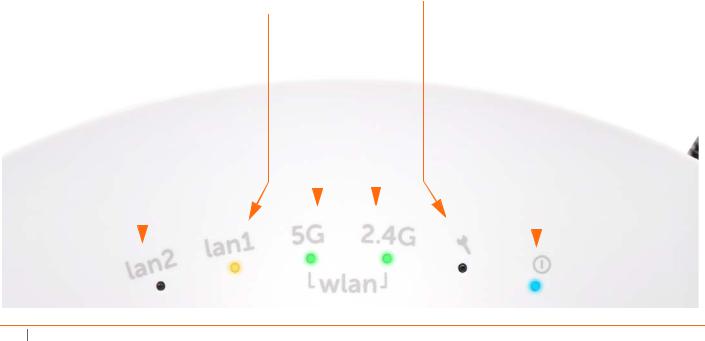Sonicwall Sonicpoint N2 User Manual

SonicWall™ SonicPoint N2
Getting Started Guide
Regulatory Model Number: APL26 0B3

Copyright © 2017 SonicWall Inc. All rights reserved.
SonicWall is a trademark or registered trademark of SonicWall Inc. and/or its affiliates in the U.S.A. and/or other countries. All other trademarks and registered trademarks are property of their respective owners
The information in this document is provided in connection with SonicWall Inc. and/or its affiliates’ products. No license, express or implied, by estoppel or otherwise, to any intellectual property right is granted by this document or in connection with the sale of SonicWall products. EXCEPT AS SET FORTH IN THE TERMS AND CONDITIONS AS SPECIFIED IN THE LICENSE AGREEMENT FOR THIS PRODUCT, SONICWALL AND/OR ITS AFFILIATES ASSUME NO LIABILITY WHATSOEVER AND DISCLAIMS ANY EXPRESS, IMPLIED OR STATUTORY WARRANTY RELATING TO ITS PRODUCTS INCLUDING, BUT NOT LIMITED TO, THE IMPLIED WARRANTY OF MERCHANTABILITY, FITNESS FOR A PARTICULAR PURPOSE, OR NON INFRINGEMENT. IN NO EVENT SHALL SONICWALL AND/OR ITS AFFILIATES BE LIABLE FOR ANY DIRECT, INDIRECT, CONSEQUENTIAL, PUNITIVE, SPECIAL OR INCIDENTAL DAMAGES (INCLUDING, WITHOUT LIMITATION, DAMAGES FOR LOSS OF PROFITS, BUSINESS INTERRUPTION OR LOSS OF INFORMATION) ARISING OUT OF THE USE OR INABILITY TO USE THIS DOCUMENT, EVEN IF SONICWALL AND/OR ITS AFFILIATES HAVE BEEN ADVISED OF THE POSSIBILITY OF SUCH DAMAGES. SonicWall and/or its affiliates make no representations or warranties with respect to the accuracy or completeness of the contents of this document and reserves the right to make changes to specifications and product descriptions at any time without notice. SonicWall Inc. and/or its affiliates do not make any commitment to update the information contained in this document.
For more information, visit https://www.sonicwall.com/legal/.
Legend
WARNING: A WARNING icon indicates a potential for property damage, personal injury, or death.
CAUTION: A CAUTION icon indicates potential damage to hardware or loss of data if instructions are not followed.
IMPORTANT, NOTE, TIP, MOBILE, or VIDEO: An information icon indicates supporting information.
SonicPoint N2 Getting Started Guide
Updated January 2017
232 003412 50 Rev A

1
Introduction
In this guide
This Getting Started Guide provides instructions for basic installation and configuration of the SonicWall™ SonicPoint N2 wireless access point in single unit or multi unit wireless deployments.
Chapter 1 |
Topics |
|
|
Introduction on page 3 |
• Wireless overview on page 5 |
|
|
SonicWall SonicPoint N2 Getting Started Guide |
|
3 |
|

Chapter 2 |
Topics |
|
|
Initial Setup on page 9 |
• Check package contents on page 9 |
|
• Deployment requirements on page 10 |
|
• SonicPoint N2 available ports/status LEDs on page 11 |
|
• Installing antennas on page 13 |
|
• Connecting Ethernet cables on page 13 |
|
• Wireless access point placement considerations on page 15 |
|
• Mounting the SonicPoint N2 on page 17 |
|
|
Chapter 3 |
Topics |
|
|
Configuring SonicOS for wireless access on page 21 |
• Configuring SonicOS for SonicPoint N2 on page 21 |
|
• Verifying SonicPoint operation on page 25 |
|
• Troubleshooting tips on page 26 |
|
|
Chapter 4 |
Topics |
|
|
Support and product registration on page 27 |
• Registration and support on page 27 |
|
• Online support and training on page 28 |
|
|
4 |
SonicWall SonicPoint N2 Getting Started Guide |

Chapter 5 |
Topics |
|
|
|
|
Product safety and regulatory information on page 29 |
• Mounting the appliance on page 30 |
|
|
• Verwarnung Weitere hinweise zur montage on page 31 |
|
|
• |
EU and EFTA on page 32 |
|
• |
Declaration of conformity on page 33 |
|
|
|
Wireless overview
The SonicPoint N2 is part of the next evolutionary generation in wireless access points after the SonicWall SonicPoint N and NDR.
The SonicPoint N2 provides physical layer enhancements for higher throughput with a maximum data rate of 450 Mbps. To achieve this, the SonicPoint N2 uses:
•More antennas—three antennas for the 5 GHz radio, and three more for the 2.4 GHz radio
•Wider channels—40 MHz wide channels for the 802.11n radio module
•More spatial streams—3X3 multiple input and multiple output, (MIMO) for the 802.11n radio module, where the capacity of a radio link is multiplied using multipath propagation.
SonicWall SonicPoint N2 Getting Started Guide |
5 |

SonicWall wireless firewalling
When a wireless device uses a SonicWall SonicPoint N2 wireless access point to communicate with a wireless device on another subnet or on a completely different network, traffic between the devices is forced to traverse the SonicWall network security appliance. This traversal enables security services to be enforced by SonicOS.
Standard practice for wireless firewalling (where one wireless client is communicating with another) bypasses many of the critical security services. The following illustration shows the standard practice for wireless firewalling.
Standard wireless firewalling
?
Other Security Appliance
|
Content Filtering Service |
|
Client Anti-Virus Enforcement |
|
Gateway Anti-Virus |
|
Gateway Anti-Spyware |
|
Intrusion Prevention Service |
WLAN Zone |
Security Services |
Many security products on the market share this potential vulnerability when two users connected by a common hub or wireless access point wish to exchange data.
SonicWall addresses this security shortcoming by managing the SonicPoint access points from the network security appliance. This allows complete control of the wireless space, including zone enforcement of security services and complete firewalling capabilities.
Secure wireless firewalling
SonicWal
SonicPoint
appliance
|
Content Filtering Service |
|
Client Anti-Virus Enforcement |
|
Gateway Anti-Virus |
|
Gateway Anti-Spyware |
|
Intrusion Prevention Service |
WLAN Zone |
Security Services |
6 SonicWall SonicPoint N2 Getting Started Guide

Frequency bands and channels
There are currently five widely adopted standards for 802.11 wireless network types: a, b, g, n, and ac. 802.11n and 802.11ac are the newest and highest capacity standards, but older client devices may not be able to utilize the newer standards.
Wireless standards |
|
|
802.11 (x) |
Frequency standard |
Maximum data rate |
|
|
|
802.11a |
5 GHz |
54 Mbps |
|
|
|
802.11b |
2.4 GHz |
11 Mbps |
|
|
|
802.11g |
2.4 GHz |
54 Mbps |
|
|
|
802.11n |
2.4 GHz and 5 GHz |
450 Mbps |
|
|
|
802.11ac |
5 GHz + multichannel + multipath |
1.3 Gbps |
|
|
|
Different frequency bands provide varying signal strength and quality over different distance ranges. Signals in the 2.4 GHz range tend to pass through physical barriers better and carry farther than those in the 5 GHz range, but they do not provide as high a data rate. Signals in the 5 GHz range provide faster data rates for better throughput, but the signal attenuates faster and is best suited for open spaces.
Strengths and weaknesses of 5 GHz and 2.4 GHz signals |
|
|
|
5 GHz |
2.4 GHz |
|
|
|
Strength |
Higher speed, more channels |
Longer Range, stronger signal penetration |
|
|
|
Weakness |
Limited penetration of walls, client compatibility |
More sources of interference |
|
|
|
SonicWall SonicPoint N2 Getting Started Guide |
7 |

Refer to Radio frequency barriers and RF interference on page 16 for detailed information about RF barriers and interference.
To allow multiple separate wireless networks in a shared and confined space, the RF medium is divided into channels. For devices in the 5 GHz range (802.11a/n/ac), this means the possibility of up to 23 discrete channels.
For devices using the 2.4 GHz range (802.11b/g/n), the wireless space is limited to a maximum of 14 overlapping channels. As a result of these overlapping channels, 2.4 GHz technology provides only a total of three discrete channels.
802.11 comparison chart
802.11 signal characteristics |
|
|
|
|
|
|
802.11a |
802.11b |
802.11g |
802.11n |
802.11ac |
|
|
|
|
|
|
# of Channels in USA |
23 |
11 |
11 |
11 |
21 |
|
|
|
|
|
|
# of Channels in EU |
23 |
13 |
13 |
13 |
16 |
|
|
|
|
|
|
# of Channels in Japan |
15 |
14 |
14 |
14 |
19 |
|
|
|
|
|
|
Frequency Band |
5 GHz |
2.4 GHz |
2.4 GHz |
2.4/5 GHz |
5 GHz |
|
|
|
|
|
|
Max. Data Rate |
54 Mbps |
11 Mbps |
54 Mbps |
450 Mbps (For |
1.3 Gbps (For QAM |
|
|
|
|
3X3 MIMO) |
64, MIMO 3X3, and 80 |
|
|
|
|
|
MHz channels) |
|
|
|
|
|
|
Radius (Range) |
90ft/25m |
120ft/35m |
120ft/35m |
300ft/90m |
120ft/35m |
|
|
|
|
|
|
NOTE: Although 802.11b/g/n standards provide between 11 and 14 channels, only three of those channels are fully discrete (non overlapping) channels.
8 |
SonicWall SonicPoint N2 Getting Started Guide |

2
Initial Setup
This section provides a basic checklist of materials, hardware information, and describes how to connect and configure physical aspects of the SonicWall SonicPoint N2 including antennas, cabling, and mounting.
•Check package contents on page 9
•Deployment requirements on page 10
•SonicPoint N2 available ports/status LEDs on page 11
•Installing antennas on page 13
•Connecting Ethernet cables on page 13
•Wireless access point placement considerations on page 15
•Mounting the SonicPoint N2 on page 17
Check package contents
Before continuing, ensure that your SonicPoint N2 package contains the following materials:
SonicWall SonicPoint N2 Getting Started Guide |
|
9 |
|

SonicPoint N2 Appliance Checklist
SonicWall SonicPoint N2 Appliance
Antennas (6)
Mounting Kit (Ceiling Brackets, Anchor and Screw Kit)
Getting Started Guide
Any items missing?
If any of the items corresponding to your product are missing from the package, contact Technical Support at: https:// support.sonicwall.com/contact support
A listing of the most current support documents are available online at: https://support.SonicWall.com/SonicWall SonicPoint series/ ace/release notes guides
Deployment requirements
SonicOS firmware
•SonicWall SonicPoint N2 access points are centrally managed by SonicWall network security appliances running the following versions of SonicOS:
•SonicOS 5.9.1.6 or a higher 5.9 release
•SonicOS 6.2.5.1 or higher
Power over Ethernet
•An 802.3at compliant PoE injector or PoE capable switch capable of providing 25 watts of power to each SonicPoint N2 is required.
Internet connectivity
•An active Internet connection is required for your firewall to download the latest SonicPoint firmware.
Gigabit Ethernet connectivity
•802.11n wireless hardware requires more bandwidth than a single (or even dual) 10/100 Ethernet connection can handle. Gigabit Ethernet connectivity between the WLAN and the LAN is required to take full advantage of 802.11n speed.
See Product safety and regulatory information on page 29.
10 SonicWall SonicPoint N2 Getting Started Guide

SonicPoint N2 available ports/status LEDs
Available ports
LAN1/PoE port.
Provides Ethernet and Power over Ethernet (PoE) connections.
LAN2 port.
Provides an additional Ethernet connection. Refer to the SonicOS Administration Guide for use cases.
Console port.
Provides a management connection using CLI > DB9 cable (for command line management only).
SonicWall SonicPoint N2 Getting Started Guide 11

Status LEDs
LED (5G)
On (solid green, 5 GHz radio link)
Blinking green (5 GHz radio activity)
LED (2.4G)
On (solid green, 2.4 GHz radio link)
Blinking (2.4 GHz radio activity)
LED (lan1) |
|
|
|
LED (Tool) |
||||
On (solid yellow or green, Ethernet link) |
|
|
|
On (solid yellow, error) |
||||
Blinking yellow (1G Ethernet activity) |
|
|
|
Blinking (safe mode) |
||||
Blinking green (10/100M Ethernet activity) |
|
|
|
|
|
|
||
LED (lan2) |
|
|
|
LED (Power) |
||||
On (solid yellow or green, Ethernet link) |
|
|
|
On (solid blue, power) |
||||
Blinking yellow (1G Ethernet activity) |
|
|
|
Blinking (booting/FW upgrade) |
||||
Blinking green (10/100M Ethernet |
|
|
|
|
|
|
||
|
|
|
|
|
|
|||
|
|
|
|
|
|
|
|
|
|
|
|
|
|
|
|
|
|
|
|
|
|
|
|
|
|
|
12 SonicWall SonicPoint N2 Getting Started Guide
